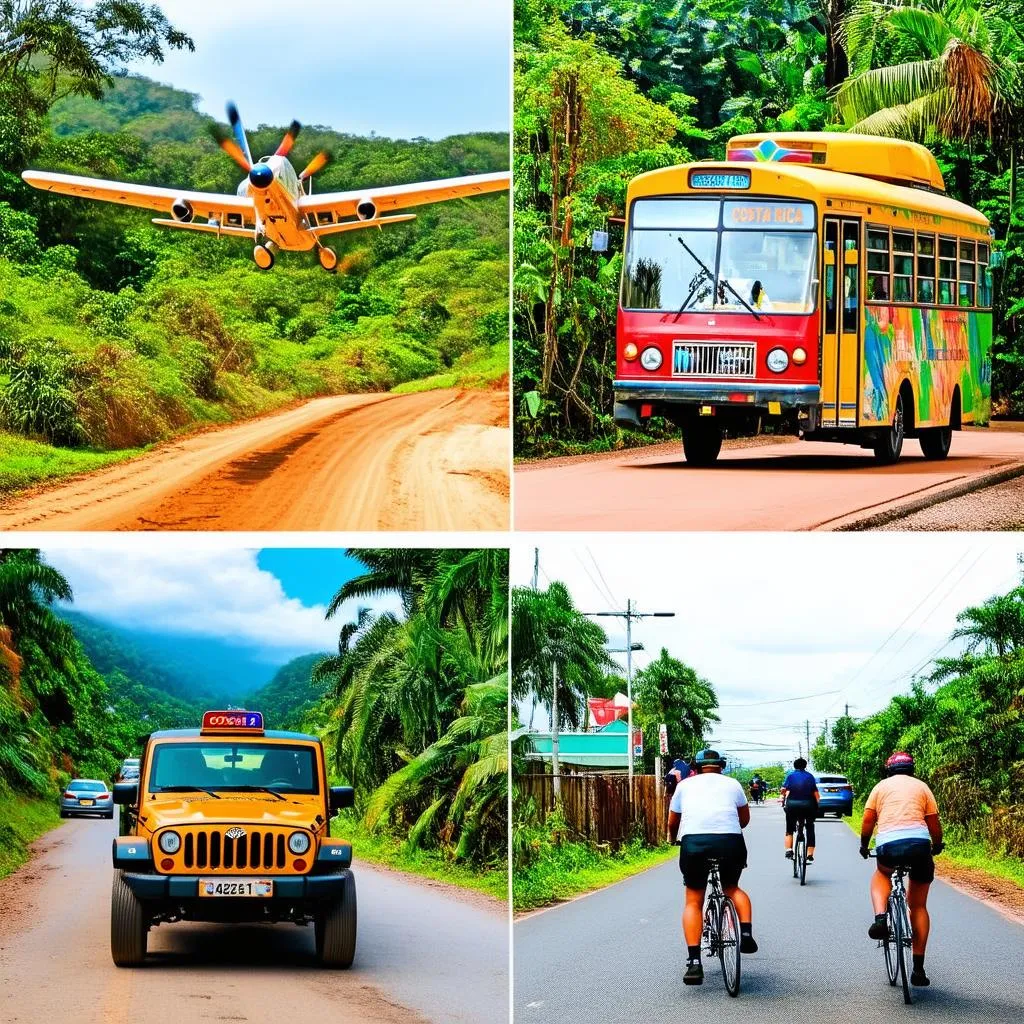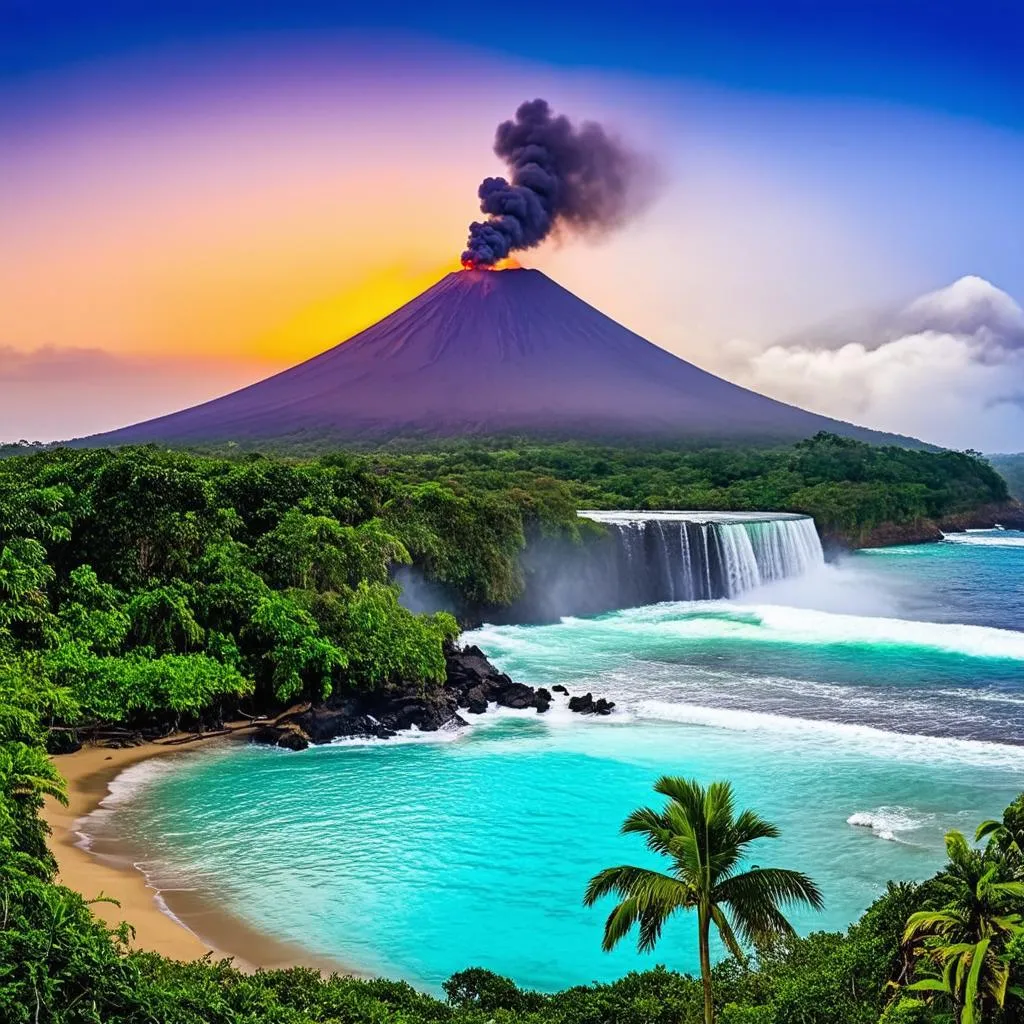“Pura Vida” – a phrase you’ll hear everywhere in Costa Rica, encapsulating the country’s laid-back lifestyle and love for life. But with its diverse landscapes, from rainforests teeming with wildlife to pristine beaches, figuring out How To Travel Around Costa Rica can seem daunting. Don’t worry; we’re here to guide you with the best ways to traverse this tropical paradise!
Getting Around Costa Rica: A Transportation Breakdown
1. Domestic Flights:
For those short on time or wanting to cover long distances quickly, domestic flights within Costa Rica are a convenient option. Sansa Airlines and Green Airways offer flights connecting major tourist destinations like San José, Liberia, and Puerto Jiménez.
Imagine soaring above the lush green canopy, catching glimpses of hidden waterfalls and pristine beaches – domestic flights offer a unique perspective of Costa Rica’s beauty!
2. Rental Cars:
Renting a car gives you the freedom to explore at your own pace, stopping at hidden gems along the way. However, road conditions can be challenging, especially during the rainy season.
Tip: A 4×4 vehicle is highly recommended, especially if you plan on venturing off the beaten path to places like Monteverde or the Osa Peninsula. Always check road conditions before heading out, and don’t be afraid to ask locals for advice.
3. Public Buses:
Costa Rica boasts an extensive and affordable public bus network connecting almost every corner of the country. It’s a great way to experience local life and immerse yourself in the culture.
Tip: Buses can get crowded, especially during peak season. Try to travel during off-peak hours for a more comfortable journey.
4. Shuttles:
Private shuttle services are a comfortable and convenient option, especially for airport transfers or traveling between major tourist destinations. They offer door-to-door service, eliminating the hassle of navigating unfamiliar routes.
For example, a shuttle from Juan Santamaría International Airport (SJO) in San José to La Fortuna (Arenal Volcano area) takes approximately 3 hours and costs around $100-150 USD.
5. Taxis and Ride-Sharing Services:
Taxis are readily available in cities and towns. Ensure they use their meters, or agree on a price beforehand. Uber and other ride-sharing apps are also operational in urban areas.
6. Other Transportation Options:
For the adventurous souls, consider exploring Costa Rica on horseback, by bicycle, or even on foot! These options allow for a more immersive experience and bring you closer to nature.
 Costa Rica Transportation Options
Costa Rica Transportation Options
Planning Your Costa Rican Adventure: Tips & Tricks
Professor Elena Garcia, author of “Unveiling Costa Rica: A Traveler’s Guide,” suggests:
“Before embarking on your journey, it’s crucial to research your desired destinations and choose transportation options that best suit your itinerary and budget.”
Budgeting for Transportation in Costa Rica
Here’s a general idea of transportation costs in Costa Rica:
| Transportation Type | Estimated Cost |
|---|---|
| Domestic Flight | $50-200 USD per flight |
| Rental Car | $30-80 USD per day |
| Public Bus | $1-10 USD per trip |
| Shuttle | $30-150 USD per trip |
| Taxi | $5-50 USD per trip |
Note: Prices may vary depending on the season, distance, and demand.
Essential Travel Tips:
- Learn Basic Spanish: While English is widely spoken in tourist areas, knowing a few basic Spanish phrases can enhance your interactions with locals and enrich your experience.
- Pack for All Weather: Costa Rica’s weather can be unpredictable. Pack lightweight clothing, rain gear, sturdy shoes, and swimwear.
- Respect Wildlife: Costa Rica is a biodiversity hotspot. Admire wildlife from a distance, avoid feeding animals, and stay on designated trails.
- Embrace “Pura Vida”: Relax, embrace the laid-back lifestyle, and enjoy the journey!
 Wildlife in Costa Rica
Wildlife in Costa Rica
Frequently Asked Questions About Traveling in Costa Rica
Is it safe to drive in Costa Rica?
Driving in Costa Rica can be challenging due to road conditions and driving habits. However, with careful planning and a 4×4 vehicle, it can be a rewarding experience.
Are there train services in Costa Rica?
Currently, there are limited passenger train services in Costa Rica.
When is the best time to visit Costa Rica?
Costa Rica has two main seasons: dry season (December-April) and rainy season (May-November). The best time to visit depends on your preferences and desired activities.
What are some must-visit destinations in Costa Rica?
Costa Rica offers something for everyone:
- Arenal Volcano & Hot Springs: Hike to volcanic craters, soak in natural hot springs, and experience thrilling adventures like ziplining and whitewater rafting.
- Monteverde Cloud Forest: Trek across hanging bridges, spot unique bird species, and immerse yourself in the mystical cloud forest ecosystem.
- Manuel Antonio National Park: Relax on pristine beaches, encounter monkeys, sloths, and other wildlife, and enjoy breathtaking ocean views.
- Corcovado National Park: Explore one of the most biodiverse places on Earth, hike through dense rainforests, and spot rare animals like jaguars and tapirs.
For more information on these destinations and other hidden gems, visit travelcar.edu.vn.
Embrace the “Pura Vida” and Explore Costa Rica!
From its vibrant culture to its breathtaking landscapes, Costa Rica offers an unforgettable travel experience. By choosing the right transportation options, planning your itinerary, and embracing the “Pura Vida” spirit, you’re sure to create memories that last a lifetime.
Share your thoughts and travel aspirations in the comments below. Let’s inspire each other to explore the beauty of Costa Rica!
 Costa Rica Scenery
Costa Rica Scenery